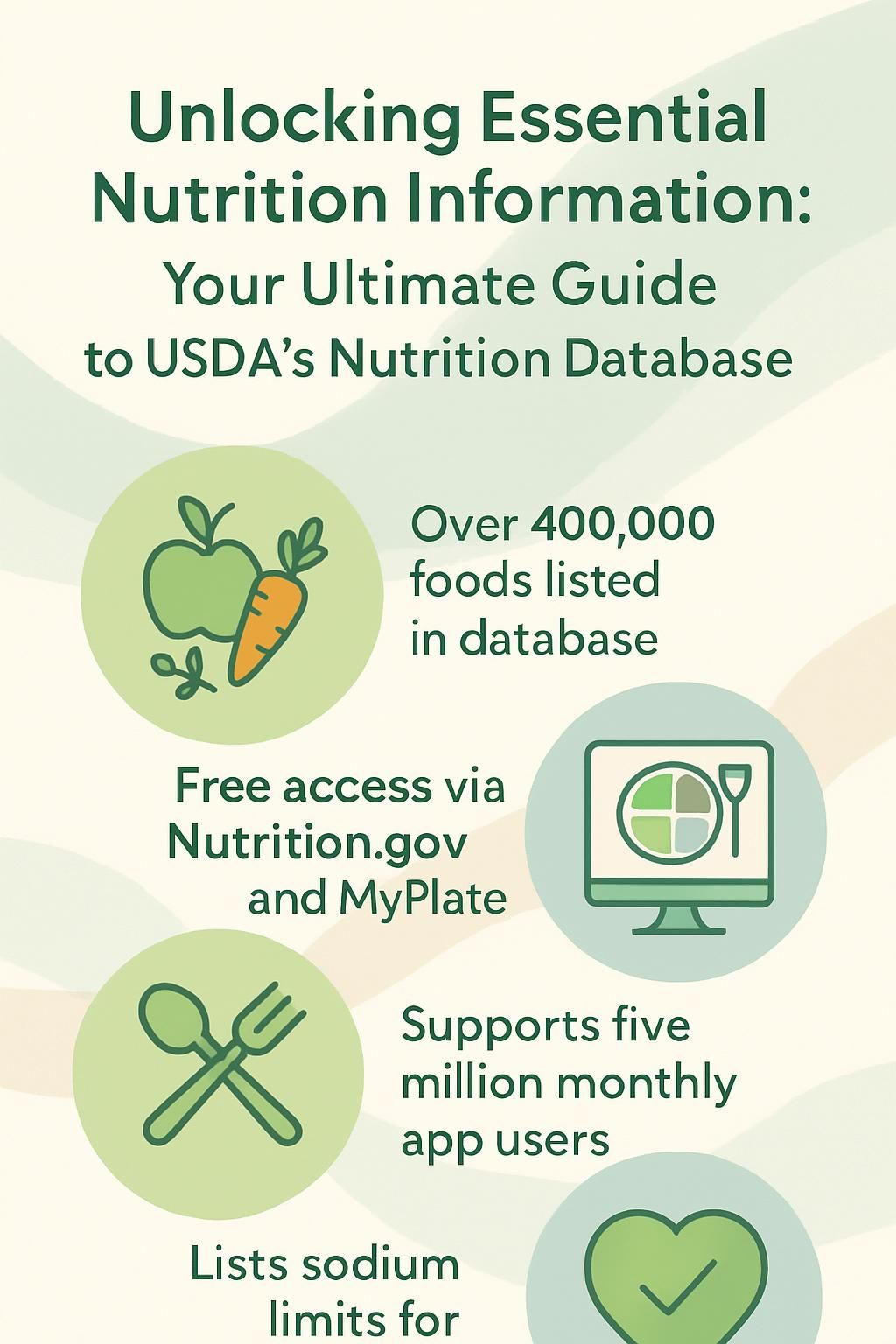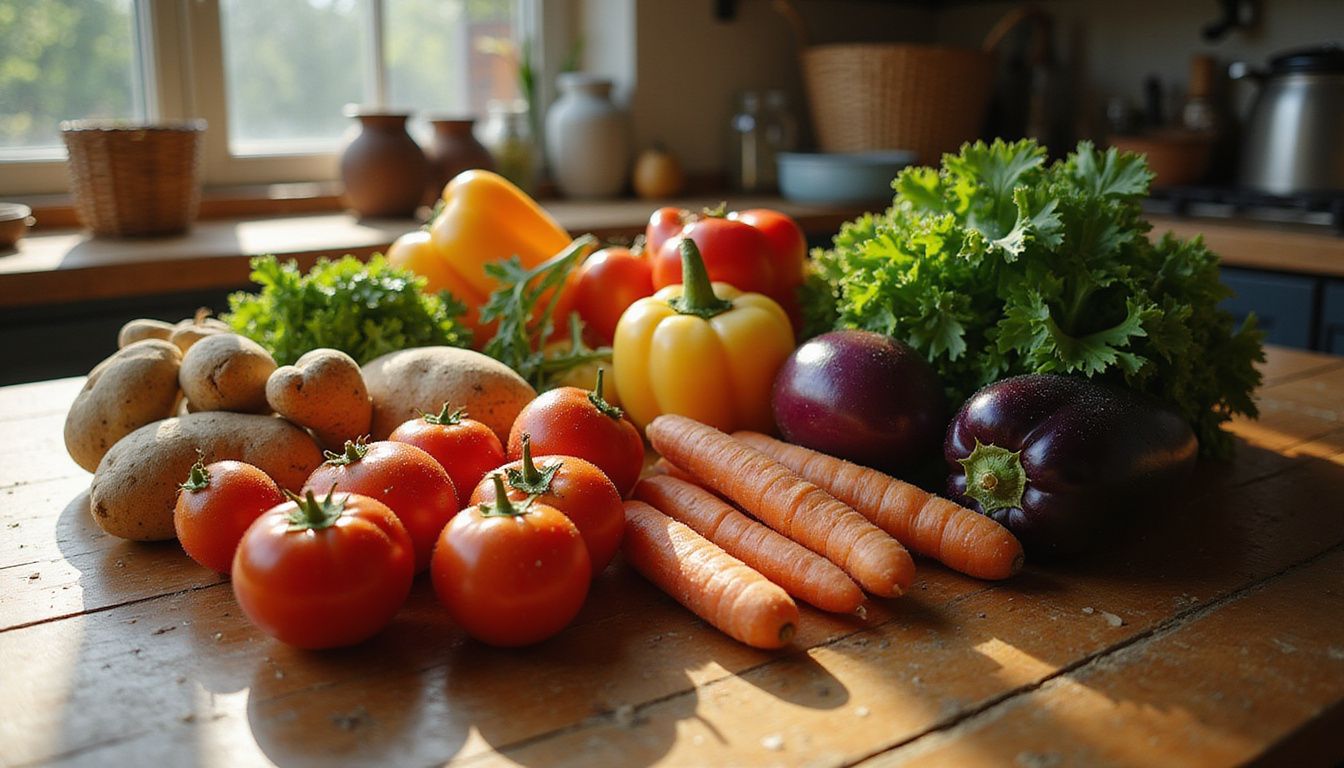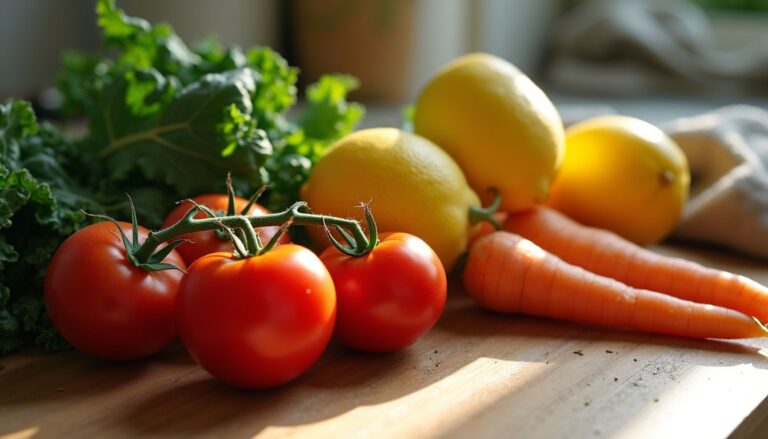Unlocking Essential Nutrition Information: Your Ultimate Guide To USDA’s Nutrition Database
Our Nutrition Assistant AI Suite will transform your body. You will lose fat, get toned, and build muscle. Gain confidence and optimal health.
Getting clear nutrition information can feel tricky, especially if food labels seem confusing. The USDA Nutrition Database, called FoodData Central, is a reliable resource that lists nutrients for hundreds of thousands of foods. Use it to plan meals, read a Nutrition Facts label with confidence, and support a healthy eating pattern.
This guide shows you how to use this resource for daily choices and meal planning. You will learn quick steps, trusted tools, and practical tips that make healthier eating feel easier.
Key Takeaways
- The USDA Nutrition Database, FoodData Central, includes nutrient data for more than 400,000 foods and informs the Dietary Guidelines for Americans 2020-2025.
- You can access this free resource through Nutrition.gov or MyPlate tools to check calories, fiber, vitamins, minerals, and other nutrition facts by food or category.
- Start Simple with MyPlate and Shop Simple with MyPlate help you set daily goals and plan budget-friendly meals using accurate USDA data.
- Health professionals and businesses rely on peer-reviewed USDA data to meet labeling laws and power nutrition apps used by over five million monthly consumers.
- 2023 figures show FoodData Central supports heart health and blood pressure management by listing sodium limits and top sources of key nutrients.

What is the USDA Nutrition Database?

The USDA Nutrition Database gives reliable numbers for nutrients in thousands of foods. It is a government resource you can use to make healthier daily choices and meet specific dietary needs.
What is FoodData Central?
FoodData Central is the main United States Department of Agriculture nutrition database. It provides nutrient information for more than 400,000 food items across many brands and categories.
The platform serves consumers, researchers, clinicians, and businesses with accurate data. Built by the Agricultural Research Service, it functions as a secure site for both research and everyday use.
You can view calories, serving sizes, fats, fiber, cholesterol, added sugars, potassium, and many vitamins and minerals. It also lists specific nutrients like vitamin D and glucose for common foods and drinks.
“FoodData Central powers trusted nutrition analysis across America.” Health experts use its data to guide eating patterns that reduce heart disease risk. It also supports federal resources such as Nutrition.gov and MyPlate.
Why is the USDA Nutrition Database important?
FoodData Central supports the Dietary Guidelines for Americans 2020-2025, so updates align with current science. This gives you a trusted base for meal planning across ages and life stages.
Nutrition.gov and MyPlate use this data to help you build balanced, nutritious meals. Schools, clinics, foodservice teams, researchers, developers using tools such as the Nutritionix API, and businesses all depend on the database for credible guidance.
You can review accurate Nutrition Facts labels for everyday items like vegetables, honey, syrup, vegetable juice, and sugar substitutes. Data on macronutrients, the big nutrients like protein and carbohydrate, and micronutrients, the vitamins and minerals, comes from tested items gathered by USDA, the United States National Agricultural Library, FDA centers, and partner sites.
These facts support tasks like setting Reference Daily Intake levels or choosing foods for the DASH eating plan to help manage high blood pressure. Having trustworthy data makes it easier to match your food choices with health goals.
Key Features of the USDA Nutrition Database
FoodData Central sits on a government site, with contributions from FDA and USDA researchers. It supplies accurate nutritional analysis so you can build a healthy diet with confidence.
What food and nutrient information does it include?
The database lists nutrient profiles for more than 400,000 foods. Each entry includes calories, carbohydrate, protein, saturated fat, fiber, vitamins, and minerals, along with serving sizes.
Entries support dietary guidance and home analysis. You can spot foods that align with heart health, weight management, or blood pressure control. Special sections highlight sodium guidance and how to cut saturated fat.
Last year I compared whole grain breads by fiber content using this tool. Clear data helped me choose options that supported our family goal to lower added sugars.
Historical menus, like a 1929 Valentine’s Day menu, provide context on how advice has changed over time. Whether you search foods helpful for pregnancy or older adults, the broad dataset supports smart choices across life stages.
Where does the data come from and how is it categorized?
FoodData Central pulls from USDA research, Nutrition.gov, and collections at the National Agricultural Library. Nutrition.gov also shares insights from scientists and partners through efforts such as ASCEND for Better Health.
Data comes from laboratory testing and large food industry surveys. These steps help the numbers meet strict scientific standards.
Foods are classified by food group, nutrient profile, and use case. You can also filter by life stage, including pregnancy, infants, children, teens, adults, and older adults. These categories make it easier to focus your search on the diets and trends that matter to you.
You can quickly filter foods for specific age groups or needs thanks to smart data organization.
How can I search and browse the database?
Searching is simple and fast. Use these steps to find nutrition facts for thousands of foods.
- Start on the FoodData Central homepage and enter a food item or brand name in the main search bar.
- Filter by category, for example fruit, vegetable, dairy, meat, grain, snack, or beverage.
- Sort results by nutrient content such as protein, fiber, added sugars, or calories.
- Browse frequently searched items or explore “Top Foods by Nutrient” lists on the site.
- Open the clickable Nutrition Facts label or summary view for quick details.
- Use MyPlate Kitchen to find recipes by ingredient or category that match your nutrition goals.
- Rely on current data pulled from national surveys and lab analyses for accuracy.
- Download datasets for custom analysis if you need data for projects or planning.
- Compare meals with the Start Simple with MyPlate app and set daily targets.
- Find budget-friendly options using Shop Simple with MyPlate, which filters for price and local availability.
What interactive tools are available for users?
MyPlate Quiz checks your eating habits and offers tips to improve. The Start Simple with MyPlate app tracks daily progress and awards badges that motivate steady change. MyPlate Kitchen helps you save recipes and build a private digital cookbook.
Nutrition.gov also hosts webinars such as “Separating Nutritional Facts from Fiction” to help you spot reliable information. Nutritionix adds consumer tools, including a mobile app for food tracking and calculators for U.S. restaurant meals. More than 100 health apps use the Nutritionix API, which serves over five million queries each month.
When I used the MyPlate app, the badges kept me engaged. The quick prompts turned small actions into habits over a few weeks.
How to Use the USDA Nutrition Database
FoodData Central can support many goals. Use it to search foods, check nutrients, and plan balanced meals with less guesswork.
How do I get started quickly?
Getting started takes only a few steps. The tools are easy to learn and free to use.
- Visit Nutrition.gov to find clear menus that lead to FoodData Central and trending topics.
- Use the FoodData Central search bar to type a food or nutrient. Results show calories, vitamins, minerals, and macronutrients.
- Try the MyPlate Quiz for a quick check of your eating habits. You will get suggestions based on national guidelines.
- Open Shop Simple with MyPlate to find healthy foods that fit your budget at local stores.
- Use MyPlate Kitchen to browse easy recipes that support meal prep and balanced lunches.
- Create a free account if you want to save favorites or track meals, though most features work without one.
- Read featured articles on Nutrition.gov for evidence-based answers to common questions.
I began using FoodData Central while planning meals for a relative with diabetes. Searching “whole wheat bread” gave accurate carb counts per serving, which helped us manage her blood sugar week by week.
How do I search by food item or category?
The search tools are built for speed. A few clicks give you the facts you need.
- Go to USDA FoodData Central, which lists data for more than 400,000 foods.
- Type any food, such as “apple” or “whole wheat bread,” into the homepage search bar.
- Apply filters by category, brand, or data type to narrow the list.
- Open a food entry to view calories, macronutrients, vitamins, and minerals.
- Use My Saved Recipes and My Cookbooks to organize your favorites.
- For recipe searches, try MyPlate Kitchen and review nutrition details per serving.
- Combine keywords like “high protein” or “low sodium” with food names for faster results.
This process gives you fast, accurate information for meal planning. It also helps you compare choices so your diet matches your goals.
What are the top foods by nutrient content?
FoodData Central helps you highlight nutrient-dense choices. Here are common standouts many people search.
- Salmon and trout are rich in omega-3 fats and protein, which support heart health.
- Spinach, kale, and other dark greens provide vitamin K, vitamin A, and fiber.
- Lentils and beans supply plant protein, iron, and fiber, based on 2023 USDA data.
- Greek yogurt and low-fat dairy offer calcium, potassium, and vitamin D for bones.
- Almonds and walnuts deliver magnesium and healthy fats that help manage cholesterol.
- Quinoa provides all essential amino acids along with several B vitamins.
- Broccoli adds vitamin C, folate, fiber, and protective antioxidants.
- Eggs contain choline and complete protein, important for muscle and brain function.
- Sweet potatoes give vitamin A as beta-carotene, plus fiber for digestion.
- Berries, such as blueberries, supply vitamin C and antioxidants in a low-calorie package.
I once used the database to plan meals for someone with high blood pressure. It guided me to low-sodium greens and beans that still delivered plenty of nutrients.
How can I use FoodData Central for meal planning?
Use the database to build weekly menus and track nutrients. Small steps make consistent progress.
- Search foods to see nutrient values for produce, packaged items, and some restaurant meals.
- Compare calories, protein, vitamins, and minerals between foods in one place.
- Filter for needs like lower sodium or higher fiber to support heart health.
- Pull MyPlate Kitchen recipes linked to FoodData Central data for affordable options.
- Save recipes and create custom cookbooks to simplify weekly planning.
- Set goals in the Start Simple with MyPlate app and track progress daily.
- Sort foods by any nutrient to find top sources, such as potassium or vitamin C.
Summary: Search, compare, filter, and save. These actions help you align meals with your health goals.
Benefits of the USDA Nutrition Database
The database puts science-backed nutrition data at your fingertips. Facts in one place make healthy choices more practical.
Who can access the database?
Anyone can use the USDA Nutrition Database through official .gov websites at no cost. Families, students, and health professionals can explore FoodData Central, MyPlate, and Nutrition.gov without special credentials.
More than five million consumers each month use Nutritionix-powered tools for tracking and planning. Food makers, retailers, and app developers also tap this data to support their users.
You can sign up for email updates or follow Nutrition.gov on social media to stay current on features and tips. Federal oversight helps keep the information credible and stable.
How reliable and accurate is the nutritional information?
USDA’s Nutrition Database offers evidence-based information reviewed by scientists and practitioners. Nutrition.gov uses secure HTTPS protocols, which protect your browsing.
Recommendations align with the Dietary Guidelines for Americans, 2020-2025. Common foods, such as apples, chicken breast, and brown rice, have nutrient values checked through lab analysis and published studies.
I once verified vitamin C numbers in FoodData Central for a school project. The values matched my teacher’s chart and supported my final report.
In short, the data is consistent and dependable for everyday decisions. It is a helpful starting point if you need to meet specific nutrition targets.
How does it support health and dietary goals?
Clear facts help you track calories, vitamins, and minerals for each food. The Start Simple with MyPlate app breaks goals into small daily actions, then tracks your progress.
Shop Simple with MyPlate points you to nutritious, low-cost options at nearby stores. Nutrition.gov offers guidance for goals like managing blood pressure and supporting heart health.
The MyPlate Quiz shows where your eating pattern stands, then suggests simple swaps. FoodData Central helps you find nutrient-dense foods so you can meet daily needs for fiber, vitamins, and minerals.
Exploring Popular Topics in Nutrition
Strong habits start with clear facts. These topics show where smart choices can have a big impact.
How does nutrition affect heart health?
Eating patterns influence heart health in powerful ways. Lowering saturated fat and cholesterol, while eating more fruits, vegetables, whole grains, and lean proteins, supports healthy blood vessels and better cholesterol levels.
USDA’s MyPlate offers recipes and practical ideas focused on heart health. Nutrition.gov shares simple steps like choosing low-sodium snacks and baking instead of frying.
Poor diets raise the risk of high blood pressure, which harms the heart over time. Evidence-based resources make it easier to pick nutrient-dense meals, one day at a time.
How can diet help manage high blood pressure?
Diet changes can lower high blood pressure. The DASH eating plan, highlighted by the USDA and Nutrition.gov, emphasizes fruits, vegetables, whole grains, and low-fat dairy.
Potassium-rich foods, such as bananas and spinach, help balance sodium. Exercise logs and meal planning tools on Nutrition.gov make tracking progress straightforward.
MyPlate Kitchen offers flavorful recipes that meet sodium goals. Choosing more fiber and fewer salty foods supports blood pressure and overall heart health.
Which foods are rich in essential nutrients?
Use FoodData Central to find nutrient-dense picks fast. These options show up often in searches.
- Leafy greens like spinach and kale provide vitamin K, folate, iron, and calcium.
- Salmon and similar fish offer omega-3 fats, vitamin D, and protein.
- Lentils and black beans supply protein, fiber, iron, magnesium, and B vitamins.
- Nuts such as pecans and walnuts add healthy fats, vitamin E, and magnesium.
- Low-fat milk and yogurt deliver calcium, potassium, vitamin D, and complete proteins.
- Oats and other whole grains provide fiber, B vitamins, iron, zinc, and selenium.
- Oranges and berries offer vitamin C, antioxidants, potassium, and fiber.
- Skinless chicken breast supplies quality protein, niacin, selenium, and phosphorus.
- Eggs provide choline for brain health and complete protein for muscles.
MyPlate tools make it easy to match foods with your goals. Set simple targets and track steady progress.
What should I know about dietary fiber and added sugar?
Dietary fiber supports digestion and can lower cholesterol. You can get it from whole grains, fruits, vegetables, and beans.
Most Americans need more fiber. Adults should aim for about 25 to 38 grams daily, depending on age and sex. MyPlate meal plans suggest easy ways to add beans, oats, or whole wheat bread.
Added sugars show up in many packaged foods, including sodas and desserts. Eating too much added sugar raises the risk for obesity and heart disease. The Dietary Guidelines for Americans recommend limiting added sugars to less than 10 percent of daily calories.
Nutrition.gov explains how to read labels so you can compare brands and pick smarter options. Over time, these small choices support better health.
Leveraging USDA Tools for Healthy Eating
USDA tools work together like a planning kit. They help you set goals, shop smart, and track progress.
What is Shop Simple with MyPlate?
Shop Simple with MyPlate helps you find healthy foods that fit your budget and location. It links to practical tips and low-cost recipes so meal planning feels manageable.
The tool also connects with USDA Nutrition Database insights. That way, you can choose foods that are both affordable and nutritious.
How does the Start Simple with MyPlate app work?
In the Start Simple with MyPlate app, you set daily goals and track them. The app gives reminders and badges to nudge steady habits. It uses data from FoodData Central to show accurate nutrition details for your choices.
During my first month, the badge system kept me logging meals. Short tips helped me reach my fruit and vegetable goals during busy weeks.
How can I set personalized goals with MyPlate?
The app makes goal setting simple. Use these steps to personalize your plan.
- Download Start Simple with MyPlate from the App Store or Google Play, then create an account.
- Take the MyPlate Quiz for a personalized snapshot based on USDA guidance.
- Pick daily or weekly goals, such as adding a vegetable to lunch or cutting sugary drinks.
- Track food choices and activity each day to see what is working.
- Set reminders so logging becomes routine.
- Save favorite recipes in MyPlate Kitchen and build quick-access cookbooks.
- Check progress charts and celebrate small wins, like three days of meeting fruit goals.
- Adjust goals as your habits improve.
- Share successes with friends for extra accountability if you like.
- Follow in-app links to FoodData Central for detailed nutrition facts while planning.
I use this weekly to plan dinners. Tracking helps our family stay on course with our fiber targets.
Advanced Applications of the USDA Nutrition Database
FoodData Central is useful beyond daily meal prep. It also supports research, product development, and detailed personal analysis.
How is it used in research and academics?
Researchers and students rely on FoodData Central to study nutrient patterns across more than 400,000 foods. Universities use it in courses, labs, and capstone projects.
Scientists analyze trends using its datasets and reference insights from ASCEND for Better Health to study food access and health differences. I used it to compare vitamin content in fruits for a class project, which made the analysis quick and credible.
Professors cite the database in peer-reviewed studies. The National Agricultural Library also connects historic materials, like the George Washington Carver exhibit, with modern data tools.
How can businesses use it for food products?
Businesses depend on USDA data to develop products and share accurate nutrition information. FoodData Central supports recipe analysis and ingredient checks for consistent labeling.
Nutritionix, a large verified nutrition database, licenses data and offers API integration for commercial use. Companies use it to power meal calculators for restaurant chains and retail items.
Accurate data helps meet labeling rules and gives customers clear menu details. This builds trust and supports transparency in marketing and on-pack labels.
How can I get a custom nutritional analysis?
If you want a quick personal analysis, apps like Nutritionix can do it in under a minute. More than 100 health applications use the Nutritionix API for this purpose.
Type foods into the app or scan package barcodes to see calories, protein, fiber, added sugars, and more, using USDA-sourced data. I entered my sandwich and scanned a yogurt, and within seconds I had a complete nutrient breakdown for the meal.
This approach helps you track intake closely and follow guidance from your healthcare provider.
USDA Nutrition Database and Public Health
FoodData Central supports public health programs, school menus, and national guidelines. It also helps communities deliver consistent nutrition education.
How does it support Dietary Guidelines for Americans?
The USDA Nutrition Database directly supports the Dietary Guidelines for Americans, 2020-2025. Its food groups, serving sizes, and nutrient data align with these national standards.
FoodData Central powers MyPlate resources with evidence-based numbers. Teachers, meal planners, and families use it to create balanced menus that match federal guidance.
I often check the database when planning family meals. It saves time and reduces guesswork.
How does it promote nutritional awareness and education?
Clear numbers and easy comparisons help people learn what is in their food. FoodData Central enables side-by-side checks of products and nutrients.
Nutrition.gov hosts the webinar series “Separating Nutritional Facts from Fiction,” which improves nutrition literacy using current research. The National Agricultural Library offers exhibits that show how advice has changed over time.
Following Nutrition.gov on Twitter gives seasonal recipes and research updates. I explored historic exhibits and found ideas that made my family’s meal planning more interesting and fun.
How does it help reduce chronic disease risks?
The database shares guidance that helps prevent long-term illnesses. Nutrition.gov highlights eating patterns, such as lower sodium and lower saturated fat, that support heart health.
Research shows that balanced diets, especially those with fewer added sugars, can reduce risks linked to hypertension and diabetes. FoodData Central and Nutrition.gov tools make it easier to log meals and compare intake with recommended levels.
I used these tools to keep our family’s sodium below 2,300 milligrams per day, as recommended by the American Heart Association. Planning with reliable data made that goal easier to reach.
How the USDA Nutrition Database Compares to Other Tools
FoodData Central follows strict scientific standards, which sets it apart from many casual food trackers. Its numbers flow into tools you may already use.
What is Nutritionix and how is it verified?
Nutritionix is one of the largest verified nutrition databases, serving more than five million consumers each month. Over 100 digital applications rely on its API to deliver real-time nutrition facts.
Registered dietitians, food scientists, and technical experts validate entries using lab results, USDA sources, and manufacturer data before publishing. I once logged a lunch in a fitness app that pulled values from Nutritionix, which made my calorie and nutrient totals clear and accurate.
What do peer-reviewed nutrition journals say?
Peer-reviewed journals often reference the USDA Nutrition Database for reliable numbers. Articles cite FoodData Central and Nutrition.gov because they align with the Dietary Guidelines for Americans, 2020-2025.
Researchers also use historic collections, such as the 1929 Valentine’s Day menu, to study long-term trends. Using USDA-linked data helps standardize research methods across dietetics and public health.
How does it integrate with other digital resources?
The credibility of USDA data makes integration easier. Nutritionix API connects with more than 100 health apps and handles over five million queries each month.
MyPlate services work with Amazon Alexa, so you can ask a voice assistant for tips at home. You can also access Nutrition.gov and MyPlate on phones and tablets, which streamlines label checks and meal planning across your devices.
Future of the USDA Nutrition Database
FoodData Central keeps growing with better tools and more open access. That means clearer guidance and faster planning for you.
What innovations are happening in nutritional science?
Researchers are using new digital tools and virtual centers to speed discovery. ASCEND for Better Health brings scientists together to study diet and disease using shared data.
Nutrition.gov hosts interactive exhibits and webinars so you can stay current on nutrition topics. MyPlate apps use personalization with USDA data to suggest next steps that fit your goals.
Ongoing updates add more nutrient detail, which improves accuracy for planning and tracking.
How will global access to nutrition data expand?
Nutritionix APIs and mobile apps make nutrition data easier to reach worldwide. People can view food information with a smartphone, even outside the United States.
FoodData Central’s open-access model supports international research and policy work. Social posts from Nutrition.gov spread recipes and tips across borders and time zones.
During a recent trip, I checked sodium levels for local foods in markets using FoodData Central. That quick check helped me stick to my meal plan while exploring new cuisines.
Conclusion
The USDA Nutrition Database makes nutrition information easy to find and use. You can search foods, compare nutrients, use MyPlate tools, and plan meals that support healthy eating for any stage of life.
Backed by USDA Science and the Dietary Guidelines for Americans, this site brings reliable data and practical tools together. Explore Nutrition.gov for webinars like “Separating Nutritional Facts from Fiction,” browse recipes in MyPlate Kitchen, and follow updates for seasonal tips.
This content is for general education and does not replace medical advice. If you have a medical condition or special dietary needs, consult a qualified healthcare professional before changing your diet.
FAQs
1. What is the USDA’s Nutrition Database and how does it help users find essential nutrition information?
The United States Department of Agriculture’s Nutrition Database is a comprehensive resource that provides detailed nutrient profiles for thousands of foods. Users can search for specific items, compare nutritional values, and access up-to-date data to make informed dietary choices. This database supports healthy eating by offering evidence-based facts about calories, vitamins, minerals, and macronutrients.
2. How reliable is the information in the USDA’s Nutrition Database?
The database uses peer-reviewed research and laboratory analyses to ensure accuracy. Data undergoes regular updates based on new scientific findings or changes in food composition standards. For example, registered dietitians often rely on this source when guiding clients because its credibility meets professional standards.
3. Can I use the USDA’s Nutrition Database for meal planning or tracking my daily intake?
Yes; individuals can use this tool to plan balanced meals or monitor their nutrient consumption over time. The platform allows users to create lists of foods they eat regularly and view summaries of total nutrients consumed each day. As someone who tracks sodium due to high blood pressure risk factors, I have found these features practical for managing my health goals.
4. Where can I access the USDA’s Nutrition Database and what types of foods are included?
Access is available online through official government websites at no cost; anyone with internet service may use it without registration requirements. The database covers a wide range of products including fresh produce like apples or spinach as well as packaged goods such as breakfast cereals or frozen entrees.
Summary:
The USDA’s Nutrition Database offers accurate nutrition details for many foods using credible sources like lab tests and expert reviews. It helps people plan meals or track nutrients easily while remaining accessible online without fees or sign-up steps required.







